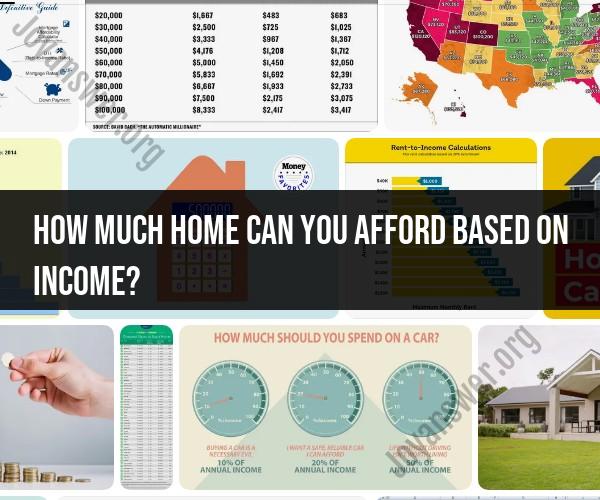How much home can you afford based on income?
The amount of home you can afford based on your income depends on several factors, including your gross annual income, monthly expenses, debt obligations, credit score, and the prevailing interest rates. Lenders typically use a debt-to-income (DTI) ratio to determine how much mortgage you can afford. A common guideline is that your total monthly debt payments (including your new mortgage) should not exceed 43% of your gross monthly income.
Here are the general steps to estimate how much home you can afford based on your income:
Calculate Your Gross Monthly Income: Start by determining your gross annual income and then divide it by 12 to get your gross monthly income.
Determine Your Monthly Debt Payments: Add up all your monthly debt obligations, including student loans, credit card payments, car loans, and any other monthly debts.
Calculate Your DTI Ratio: Divide your total monthly debt payments by your gross monthly income. Multiply the result by 100 to get a percentage. Lenders typically look for a DTI ratio of 43% or lower.
Consider Your Down Payment: Decide how much of a down payment you can afford. A common guideline is to aim for a down payment of at least 20% of the home's purchase price to avoid private mortgage insurance (PMI).
Consider Interest Rates: Interest rates can significantly affect the amount of mortgage you can afford. Lower interest rates may allow you to afford a higher-priced home for the same monthly payment.
Use an Affordability Calculator: Many financial websites and mortgage lenders offer online affordability calculators. These tools can help you estimate how much home you can afford based on your income, debt, and other financial factors.
Consider Your Comfort Level: While lenders provide guidelines, it's also important to consider your personal financial situation and comfort level. You might be approved for a certain amount, but it doesn't mean you should max out your budget. Consider your lifestyle, other financial goals, and the potential for unexpected expenses.
Get Pre-Approved: A pre-approval from a mortgage lender can give you a more accurate idea of how much you can afford. It involves a detailed financial assessment, which can be helpful when shopping for a home.
Remember that in addition to the mortgage payment, you'll have to budget for property taxes, homeowner's insurance, utilities, maintenance, and other homeownership costs. It's essential to have a clear understanding of your overall financial situation and the long-term affordability of homeownership. Consulting with a financial advisor or a mortgage professional can be beneficial in making an informed decision about how much home you can afford based on your income and financial circumstances.
Determining Home Affordability Based on Income: A Practical Guide
Determining home affordability based on income is an important step in the home buying process. It is important to be realistic about how much you can afford to spend on a home and to avoid overextending yourself financially.
A good rule of thumb is to spend no more than 28% of your gross monthly income on your mortgage payment. This will leave you with enough money to cover other expenses, such as property taxes, homeowners insurance, and utilities.
Another important factor to consider is your debt-to-income ratio (DTI). This is the percentage of your gross monthly income that goes towards debt payments. Lenders typically want to see a DTI of no more than 36%, but lower is better.
To determine your home affordability, you can use a mortgage calculator. This will take into account your income, DTI, and other factors to estimate how much you can afford to borrow and what your monthly mortgage payments will be.
The Role of Income in Home Affordability Calculations
Income is the most important factor in home affordability calculations. Lenders use your income to determine how much you can afford to borrow. The higher your income, the more you can borrow.
However, it is important to remember that income is just one factor. Lenders will also consider your DTI and other factors, such as your credit score and employment history.
Budgeting and Financial Planning for Home Purchase
Once you have determined how much you can afford to spend on a home, it is important to create a budget and financial plan for your home purchase. This will help you to save for a down payment and to avoid overspending on your mortgage.
When creating your budget, be sure to factor in all of the costs of homeownership, such as property taxes, homeowners insurance, and utilities. You should also set aside money for unexpected expenses, such as repairs and maintenance.
Mortgage Pre-Approval and Home Price Range
Once you have saved for a down payment and created a budget, you can start looking at homes. Before you start making offers, it is important to get pre-approved for a mortgage. This will give you an idea of how much money you can borrow and what your monthly mortgage payments will be.
When looking at homes, it is important to stay within your price range. It is also important to consider the location of the home and the condition of the property.
Strategies for Managing Homeownership Costs and Budgeting
Once you have purchased a home, it is important to develop strategies for managing your homeownership costs and budgeting. Here are a few tips:
- Create a budget and track your spending. This will help you to identify areas where you can cut back.
- Shop around for insurance and other services. Compare rates from different providers to get the best deal.
- Make extra mortgage payments. This will help you to pay off your mortgage faster and save money on interest.
- Set up a maintenance fund. This will help you to cover unexpected expenses, such as repairs and maintenance.
Homeownership can be a great investment, but it is important to be financially prepared. By following the tips above, you can manage your homeownership costs and budget effectively.













